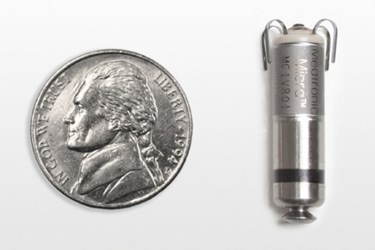Medtronic Touts Leadless Pacemaker Data At Heart Rhythm 2016
By Jof Enriquez,
Follow me on Twitter @jofenriq

Medical device companies Medtronic, St. Jude, and Boston Scientific touted positive safety data on their competing leadless pacemakers at Heart Rhythm 2016, the 37th Annual Scientific Sessions of the Heart Rhythm Society (HRS) in San Francisco.
Medtronic presented three- and six-months post-implant data for its FDA-approved Micra Transcatheter Pacing System (TPS), which successfully delivered appropriate rate-responsive pacing in 20 patients who pushed to maximal exertion during treadmill tests. The study confirmed that Micra's accelerometer can safely adjust cardiac pacing to match a patient's activity level, the company said.
"Many patients with bradycardia require rate-responsive pacing so that their heart rates increase during exercise," said Razali Omar, M.D., senior consultant cardiologist at the National Heart Institute in Kuala Lumpur, Malaysia, in a statement. "Conventional pacemakers use various sensors outside the heart to detect patient activity, but even these sensors can have difficulty detecting moderate physical activity. As data presented today show, the Micra accurately responds to patients' activity levels by adjusting therapy when needed using a sensor within the heart."
Previous data published in The New England Journal of Medicine in November demonstrated that Micra was successfully implanted in 99.2 percent of patients and met safety and effectiveness endpoints with wide margins. The vitamin pill-sized device received a CE Mark in April 2015 and FDA approval last month. Medtronic says the Micra design incorporates a unique feature to enable retrieval when needed, but the device is designed to be left in the body.
In presenting data at HRS for its Nanostim leadless pacemaker, St. Jude Medical highlighted the retrievability of the device over the competition, pointing out that patients may need these implants removed because of changing medical conditions over time. St. Jude’s LEADLESS II IDE study and the LEADLESS Observational Study showed that the Nanostim device was successfully retrieved in 14 patients, up to 3.2 years post-implantation, without serious adverse events.
“Device retrieval is a desirable feature of implanted leadless pacemakers because it offers physicians options in the future so that we can provide optimal care for our patients,” said Dr. Vivek Reddy, primary investigator of the LEADLESS II study and the director of electrophysiology from Mount Sinai Hospital in New York, NY, in a statement. “We’ve now shown that for patients requiring device upgrades or new leadless pacing options, late retrievability — even up to three years — is possible with the Nanostim leadless pacemaker.”
St. Jude presented two additional studies that showed patients implanted with Nanostim had fewer complications in both at-first-month and at-two-years post-implant.
“The Nanostim leadless pacemaker has been available to patients in Europe since 2013 and we continue to work with the FDA to bring the Nanostim leadless pacemaker to the U.S. market to ensure broad patient access to this important therapy,” said Dr. Mark Carlson, VP of global clinical affairs and chief medical officer at St. Jude Medical.
While Medtronic and St. Jude are faster to market with their leadless pacemakers, Boston Scientific's rival device is still in development. Dr. Ken Stein, senior VP and chief medical officer at Boston Scientific CRM, told MDO in a recent interview that – unlike competing leadless pacemakers designed to be simple, single-chamber pacemakers – Boston Scientific’s EMPOWER device is part of a modular system designed to work with the company’s subcutaneous implantable cardioverter defibrillator (S-ICD).
“We are building on the success we've seen with the S-ICD system by exploring a modular therapy approach that keeps the vasculature untouched," said Stein in a statement. "Whether patients with life-threatening arrhythmias subsequently develop a need for pacing or vice versa, we are designing this modular solution to enable electrophysiologists to treat patients with the therapies they need, when they need them.”
Stein shared in the interview with MDO that, "we have gone through several rounds of pre-clinical testing. We expect to have a design freeze on the system at some point in 2016, and then to begin human clinical trials shortly thereafter."
Medtronic, St. Jude, and Boston Scientific were invited in February by an FDA panel to discuss and make recommendations regarding cardiac pacemaker device technology. Because the long-term safety profiles of these novel medical devices are not yet established, the panel recommended that patients implanted with the novel devices be monitored extensively for the duration of the devices’ battery life.
